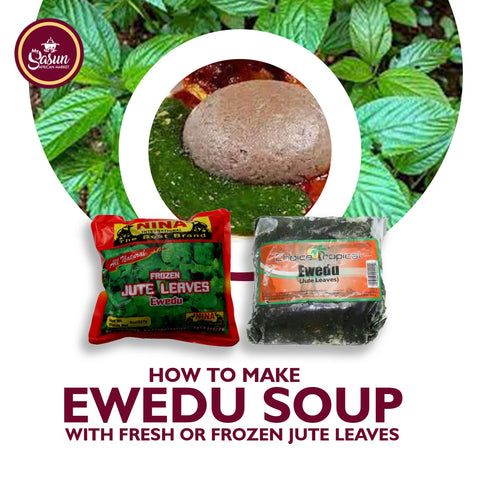Ewedu soup is a delicious and nutritious soup that originates from the Yoruba people of Nigeria. It is made with jute leaves, also known as ewedu, which have a slimy texture and a mild flavor. Ewedu soup is usually served with beans stew (gbegiri), beef stew, or fish stew, and accompanied by a solid meal (known as swallow) like pounded yam, fufu, or amala.

Ewedu soup is not only popular in Nigeria, but also among Africans abroad who crave for a taste of home. If you are living in the US and you want to enjoy ewedu soup with your swallows, you can get fresh and frozen jute leaves at My Sasun African Market. We deliver to all states of the US and have two pick-up locations in Texas: Celina and Houston. You can order online or call us at 1(833) 541-2120.
Jute leaves are rich in vitamins, minerals, antioxidants, and fiber. They can help lower blood pressure, cholesterol, and blood sugar levels, as well as boost immunity and digestion. Jute leaves are also known to have anti-inflammatory, anti-microbial, and anti-cancer properties.
You can make ewedu soup with fresh or frozen jute leaves, depending on what is available to you. Fresh jute leaves are preferable, as they retain more of their natural flavor and color. However, frozen jute leaves are also convenient and easy to use, as they come pre-washed and chopped.

Also Read: 27 DELICIOUS WEST AFRICAN SOUPS
HEALTH BENEFITS OF EWEDU
Ewedu is rich in vitamins, minerals, antioxidants, and fiber. They can help lower blood pressure, cholesterol, and blood sugar levels, as well as boost immunity and digestion. Ewedu is also known to have anti-inflammatory, anti-microbial, and anti-cancer properties. Other main health benefits of Ewedu include:
- Acne prevention and treatment:
Ewedu contains vitamin A, which can help to control the secretion of sebum and reduce the appearance of acne.
- Strengthening bones and teeth:
Ewedu contains calcium and phosphorus, which maintain bone density and prevent the risk of osteoporosis.
- Aids digestion and weight loss:
Ewedu is an excellent source of dietary fiber, which aids digestion and bowel movement, and reduces the chances of constipation. It also contains other nutrients like vitamin B and magnesium that help to maintain weight.

INGREDIENTS FOR MAKING EWEDU SOUP
To make ewedu soup with fresh or frozen jute leaves, you will need the following ingredients:
- 3 cups of ewedu leaves (fresh or frozen)
- 2 tablespoons of locust beans (iru)
- 1 tablespoon of ground crayfish (optional)
- Bicarbonate of soda (optional) - a pinch
- 1 seasoning cube (optional)
- Salt to taste
- Water - about 2 cups
DIRECTIONS FOR MAKING EWEDU SOUP
You can make ewedu soup with fresh or frozen jute leaves, depending on what is available to you. Fresh jute leaves are preferable, as they retain more of their natural flavor and color. However, frozen jute leaves are also convenient and easy to use, as they come pre-washed and chopped.
The traditional way of making ewedu soup is with the use of a broom, known as Ijabe or hand blender. This method requires potash, which is a substance that helps to soften the jute leaves and make them more pliable. The Ijabe is used to pound the leaves until they form a light slimy soup. However, you can also make ewedu soup with the use of a blender, which is a quick and easy method that does not require potash. For the sake of this blog, we'd be exploring the blender method. Here's how to make Ewedu with your blender:

Also Read: HEALTH BENEFITS AND PRECAUTIONS OF USING POTASH IN COOKING
- If you are using fresh jute leaves, wash them thoroughly and remove the stems. You can do this by folding the leaves and pulling them off the stem. Discard the stems and chop the leaves roughly. If you are using frozen jute leaves, thaw them and drain the excess water.
- In a blender, add the jute leaves and a little water. Blend until smooth (or to the consistency that you prefer) and set aside.
- In a pot, bring some water to a boil. If you are using fresh jute leaves, you can add a pinch of bicarbonate of soda to help the leaves retain their green color and viscosity. This is optional, and you can skip it if you don’t like it.
- Add the blended jute leaves to the boiling water and stir well. Reduce the heat and simmer for about 10 minutes, stirring occasionally.
- Add the locust beans, crayfish, salt, and bouillon powder and stir well. Taste and adjust the seasoning as needed. Cook for another 5 minutes, then turn off the heat.
- Your ewedu soup is ready to serve. Enjoy it with your choice of stew and solid meal.

Rounding Off:
We hope you enjoyed this blog post and learned how to make ewedu soup with fresh or frozen jute leaves. Ewedu soup is a healthy and tasty dish that you can make at home with ease. Try it today and let us know what you think. Don’t forget that you can get fresh and frozen jute leaves at My Sasun African Market. We deliver to all states of the US and have two pick-up locations in Texas: Celina and Houston. You can order online or call us at 1(833) 541-2120. Thank you for reading and happy cooking!







Comments (1)
My heart is so filled with joy. If you are suffering from Erectile dysfunction or any other disease you can contact Dr. Moses Buba on this buba.herbalmiraclemedicine@gmail.com or His website : https://www.facebook.com/profile.php?id=61559577240930 . For more information from me reach me via WhatsApp : +44 7375 301397